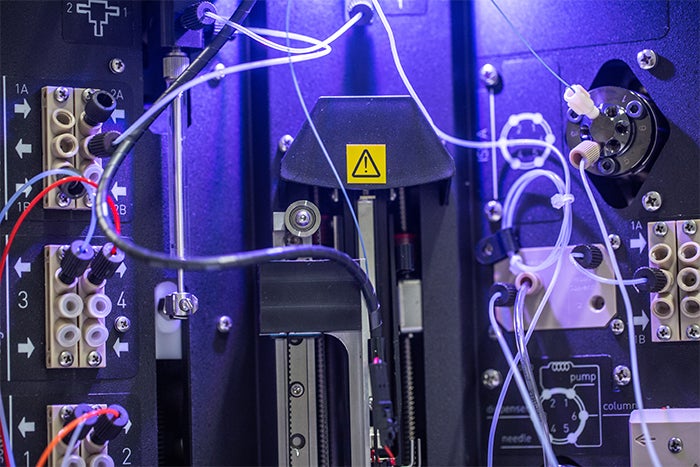FractioMate™ FRM100
A contact-free high-frequency spotter deviceThe FractioMate™ is a contact-free high-frequency spotter device, ejecting droplets for HT-EDA. It is the bridging unit integrating biological toxicity responses with chemical data.
Post-column after chromatographic separation the flow is split and directed to the FractioMate™ and e.g. to a mass spectrometer, allowing high-resolution fractionation of an environmental extract, in parallel with the acquisition of chemical data.
FractioMate™ converts complex, costly and lengthy EDA studies into robust, rapid and sensitive analyses, which also significantly improves toxic compound identification.
FractioMate Video
Usability
Fraction collection of liquid chromatographic (LC) separations is used for analyte purification, but also for applications in which a detection technique cannot be coupled online to LC due to compatibility issues. It is most common to apply fractionation in environmental toxicant screening, drug discovery research and food chemistry, combining chemical analysis with bioassay testing for the identification of bioactive substances. In these types of studies, fractionation is required to reduce the sample complexity until preferably only one single compound is present in a fraction. Subsequently, each fraction is tested for biological activity and the detected bioactives are potentially identified.
Alternatively, this approach is used to purify sufficient amounts of material for typical off-line analyses such as NMR. This traditional process usually requires many orthogonal separations to obtain the pure compounds for chemical structure elucidation and furthermore many repeated fractionation cycles are required for analyte isolation.
All this results in a very costly process that is time consuming and prone to analyte losses. In environmental chemistry, this huge bottleneck has recently been solved by establishing High- Throughput Effect-Directed-Analysis (HT-EDA) which shifted traditional EDA towards high resolution small-volume fractionation.
Compounds in a sample are separated with liquid chromatography (LC). Subsequently, the eluent is split and one part is transferred by the innovative FractioMate spotting technology to a high-resolution bioassay (e.g. 96 or 384 well mammalian or yeast-based cellular format) to test the biological activity of eluting compounds. The other part is directed to a mass spectrometer. Peak shapes from ‘reconstructed bioassay chromatograms’ using the individually collected and bioassayed fractions are efficiently correlated to compound accurate masses from the parallel obtained chemical data (in most cases MS data).


Features
- Direct integration of biological and chemical lab.
- Lengthy EDA studies reduced to a few days.
- Capacity increase by orders of magnitude; resulting in 5 to 10 samples per week.
- Integration results in much faster correlation of bioactivity / toxicity to accurate mass.
Specifications
- Optimized for UHPLC
- Low dead volume spotting / dispensing
- Standard configuration with two well plates
- Suited for most liquid chromatography post-column fractionation applications
- Adjustable 1s > well fractionation time
- Dispense precision ≤ 4.4% CV
- Standard 96 and 384 well plate spotting for nanofractionation
- Flow rate 10μl/min – 1ml/min
- Spot volume 0.1μl- 1.7μl
- Spotting frequency 1-50Hz
Download
Credentials
The FractioMateTM is developed at the Vrije Universiteit Amsterdam by the BioMolecular Analysis group, Jeroen Kool en Marja Lamoree, the department of Environment & Health and the Electronics and Mechanics groups of the Faculty of Science in close cooperation with SPARK and Waterlaboratorium, Haarlem the Netherlands.
Read also the credential of Marja Lamoree of the BioMolecular Analyses Group Vrije Universiteit Amsterdam.
Related publications
High-Throughput Effect-Directed Analysis Using Downscaled in Vitro Reporter Gene Assays To Identify Endocrine Disruptors in Surface Water in ‘Evironmental Science and technology’ 2018, 52.
Nick Zwart, Shan Li Nio, Corine J. Houtman, Jacob de Boer, Jeroen Kool, Timo Hamers and Marja H. Lamoree
Department of Environment & Health, VU University, Amsterdam, The Netherlands; Waterlaboratorium, Haarlem, The Netherlands; Biomolecular Analysis Group, Vrije Universiteit Amsterdam, The Netherlands
More information
Precision Mechanics and Engineering Group VU
Joost Rosier
T +31 20 59 87439
E j.c.rosier@vu.nl
